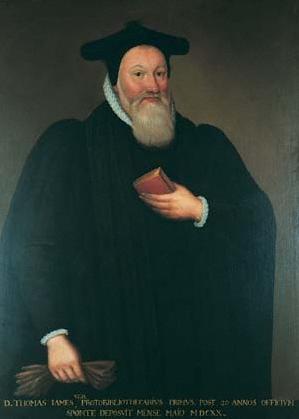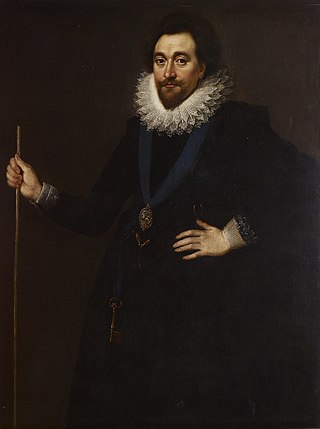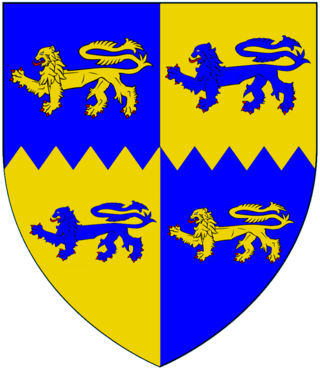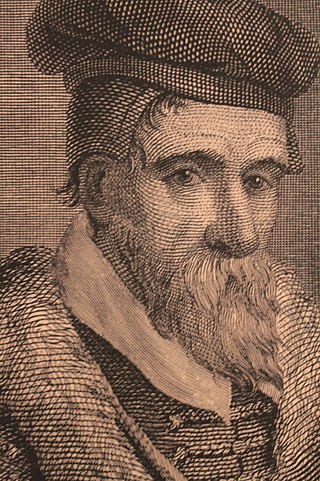Related Research Articles

Thomas James was an English librarian and Anglican clergyman, the first librarian of the Bodleian Library, Oxford.

Antoine de Laloubère, also Lalouvère and other forms,, a Jesuit, born in Languedoc, is chiefly known for an incorrect solution of Pascal's problems on the cycloid, which he gave in 1660, but he has a better claim to distinction in having been the first mathematician to study the properties of the helix.
Adriaan van Roomen, also known as Adrianus Romanus, was a mathematician, professor of medicine and medical astrologer from the Duchy of Brabant in the Habsburg Netherlands who was active throughout Central Europe in the late 16th and early 17th centuries. As a mathematician he worked in algebra, trigonometry and geometry; and on the decimal expansion of pi. He solved the Problem of Apollonius using a new method that involved intersecting hyperbolas. He also wrote on the Gregorian calendar reform.

Sir Henry Savile was an English scholar and mathematician, Warden of Merton College, Oxford, and Provost of Eton. He endowed the Savilian chairs of Astronomy and of Geometry at Oxford University, and was one of the scholars who translated the New Testament from Greek into English. He was a Member of the Parliament of England for Bossiney in Cornwall in 1589, and Dunwich in Suffolk in 1593.

William Herbert, 3rd Earl of Pembroke, of Wilton House in Wiltshire, was an English nobleman, politician and courtier. He served as Chancellor of the University of Oxford and together with King James I founded Pembroke College, Oxford. In 1608 he was appointed Warden of the Forest of Dean, Constable of St Briavels Castle, Gloucestershire, and in 1609 Governor of Portsmouth, all of which offices he retained until his death. He served as Lord Chamberlain from 1615 to 1625. In 1623 the First Folio of Shakespeare's plays was dedicated to him and his brother and successor Philip Herbert, 1st Earl of Montgomery.

Grégoire de Saint-Vincent - in Latin : Gregorius a Sancto Vincentio, in Dutch : Gregorius van St-Vincent - was a Flemish Jesuit and mathematician. He is remembered for his work on quadrature of the hyperbola.

Robert Hues was an English mathematician and geographer. He attended St. Mary Hall at Oxford, and graduated in 1578. Hues became interested in geography and mathematics, and studied navigation at a school set up by Walter Raleigh. During a trip to Newfoundland, he made observations which caused him to doubt the accepted published values for variations of the compass. Between 1586 and 1588, Hues travelled with Thomas Cavendish on a circumnavigation of the globe, performing astronomical observations and taking the latitudes of places they visited. Beginning in August 1591, Hues and Cavendish again set out on another circumnavigation of the globe. During the voyage, Hues made astronomical observations in the South Atlantic, and continued his observations of the variation of the compass at various latitudes and at the Equator. Cavendish died on the journey in 1592, and Hues returned to England the following year.
Sir William Temple (1555–1627) was an English Ramist logician and fourth Provost of Trinity College Dublin.
Edmund Dickinson or Dickenson (1624–1707) was an English royal physician and alchemist, author of a syncretic philosophical system.

Luca Valerio (1553–1618) was an Italian mathematician. He developed ways to find volumes and centers of gravity of solid bodies using the methods of Archimedes. He corresponded with Galileo Galilei and was a member of the Accademia dei Lincei.
Sir Humphrey Lynde (1579–1636) was an English lay Puritan controversialist and politician who sat in the House of Commons in 1626.

Sir Thomas Jermyn (1573–1645) of Rushbrooke, Suffolk, was an English Royalist soldier and politician who was a Member of Parliament between 1604 and 1640. He became an influential courtier and served as Comptroller of the Household to Charles I from 1639 to 1641.

Edward Cromwell, 3rd Baron Cromwell was an English peer. He was the son of Henry Cromwell, 2nd Baron Cromwell by his wife Mary, daughter of John Paulet, 2nd Marquess of Winchester and his first wife Elizabeth Willoughby. His grandfather, Gregory, son of Thomas Cromwell, chief minister to Henry VIII, was created Baron Cromwell on 18 December 1540.
Sir William Herrick or Hericke was an English jeweller, courtier, diplomat and politician who sat in the House of Commons at various times between 1601 and 1622.
Thomas Wright (1561-1624) was an English recusant and early emotion theorist. Wright is known for his work The Passions of the Minde in generall. Wright is a possible candidate for the priest Ben Jonson referenced during the trials for the Gunpowder Plot.

Sir Henry Belasyse, 1st Baronet (1555–1624) was an English politician.

Peter Turner M.D. (1542–1614) was an English physician, known as a follower of Paracelsus. He also was a Member of Parliament, during the 1580s.
Thomas Moundeford M.D. (1550–1630) was an English academic and physician, President of the London College of Physicians for three periods.
Samuel Norton (1548–1621) was an English country gentleman and alchemist.

Duncan Liddel was a Scottish mathematician, physician and astronomer.
References
- Specific
- 1 2 3 Thomas, Ivo (1965). "The Written Liar and Thomas Oliver". Notre Dame Journal of Formal Logic. VI (3): 203. doi: 10.1305/ndjfl/1093958258 .
- ↑ Oliver, Thomas (1604). De sophismatum praestigiis cavendis tractatus paraeneticus. Cambridge.
- General
![]() This article incorporates text from a publication now in the public domain : Lee, Sidney (1895). "Oliver, Thomas (d.1624)". In Lee, Sidney (ed.). Dictionary of National Biography . Vol. 42. London: Smith, Elder & Co.
This article incorporates text from a publication now in the public domain : Lee, Sidney (1895). "Oliver, Thomas (d.1624)". In Lee, Sidney (ed.). Dictionary of National Biography . Vol. 42. London: Smith, Elder & Co.